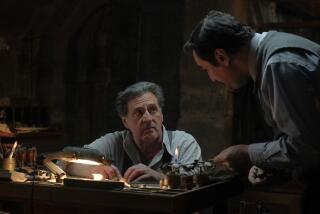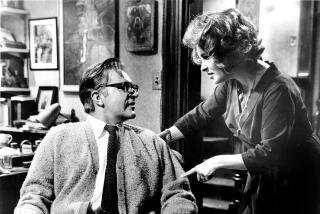‘A Dangerous Method’ review: Mortensen, Fassbender mesmerize
Before it became known as psychoanalysis, the radical new method of dealing with emotional crises pioneered by Sigmund Freud, Carl Jung and others was known simply as “the talking cure.” And it is talk — smart, satisfying and sometimes even thrilling — that is at the heart of “A Dangerous Method.”
“Method” stars Viggo Mortensen as Freud, Michael Fassbender as Jung, and a game but somewhat miscast Keira Knightley as Sabina Spielrein, a woman who influenced them both. The confident directing style of David Cronenberg is essential in making this kind of intellectually stimulating cinema look easy, but the critical component in the film’s success is Christopher Hampton’s classically well-written script.
Hampton’s credits (including his Oscar-winning “Dangerous Liaisons,” “Atonement” and the Michael Caine-starrer “The Quiet American”) are for the most part adaptations, and here he is working from both his own play on the subject (called “The Talking Cure”) and John Kerr’s “A Most Dangerous Method,” a comprehensive history of this three-way relationship.
If Hampton’s literate script provides the essential language, Mortensen and Fassbender do such a splendid job of turning iconic figures such as Freud and Jung into compelling people that it is a shock to hear that others (Christoph Waltz for Freud, Christian Bale for Jung) almost got the parts.
These actors, along with costar Vincent Cassel, are strong enough to compensate for Knightley’s weaknesses. She improves as the film goes on, but her performance lacks the substance to make us believe that her character is as crucial to both men’s careers as history insists.
It’s unfortunate that “Dangerous Method” begins with Knightley’s least convincing moments, her arrival in 1904 at Jung’s Burgholzli clinic in Zurich as the 18-year-old Spielrein, screaming, ranting and in the throes of complete hysteria. Knightley certainly throws herself into these scenes, but what we see comes off as an actress acting crazy rather than a character going mad.
The buttoned-down Jung tells his wealthy and proper wife Emma (Canadian actress Sarah Gadon) that Spielrein might be a good candidate for this new talking method of Freud’s he’s been reading about.
Under Jung’s care, Spielrein’s quite severe problems emerge: beatings by her father lead to sexual arousal, making her feel “there is no help for me, I am vile and filthy and corrupt.” But also coming into focus is the woman’s intelligence, insight and desire to be a physician, even a psychiatrist.
Jung’s continued interest in Freud’s methods lead to one of the film’s high points, their 1906 meeting in Vienna. The two men have so much to say to each other that that initial encounter turns into a 13-hour conversation.
In this meeting, and in the film as a whole, it helps that Cronenberg has cast both Jung and Freud slightly against type. It’s fascinating to see the exceptionally charismatic Fassbender squeeze himself into the role of the aristocratic, restrained Jung, and it’s just as enjoyable to see Mortensen bring an unexpected virility to his sybaritic, cigar-chomping Freud.
With psychiatric practice in its infancy, neither man is sure what will happen next. “I’ve set my feet on the shore and the country exists,” is all Freud is prepared to say with confidence, but he does initially see Jung as his likeliest crown prince and heir.
What neither man expects is that once Jung returns to Zurich, Spielrein, hungry for experience, will want to begin a sexual relationship with him, which he as her doctor initially rejects. Then a new patient, the wealthy Otto Gross, sent to Burgholzli by Freud, enters the picture.
Seductively played by French actor Cassel, Gross is an immensely charming, cocaine-sniffing social nihilist whose motto is “never repress anything.” A man who believes “pleasure is simple until we decide to complicate it,” he influences Jung’s thoughts about Spielrein, and that in turn creates problems in Jung’s increasingly complex relationship with Freud.
Though its conventional surface makes this not the norm for director Cronenberg, whose credits include “Naked Lunch,” based on the William S. Burroughs novel, and 1996’s J.G. Ballard adaptation “Crash,” the film’s fascination with the creative and destructive force of sexuality means that “A Dangerous Method” is a good fit for him thematically.
When a director who perennially goes for broke decides to exercise restraint on screen, as Cronenberg did with one of his previous collaborations with Mortensen, the compelling “A History of Violence,” the results are invariably worth the effort.
More to Read
The biggest entertainment stories
Get our big stories about Hollywood, film, television, music, arts, culture and more right in your inbox as soon as they publish.
You may occasionally receive promotional content from the Los Angeles Times.







